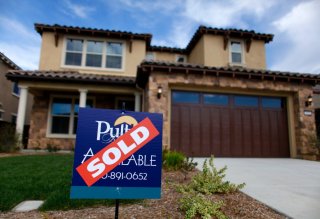Will Housing Prices Go Through the Roof in 2022?
There will not be much relief in the housing market for the rest of the year.
There’s no question that Federal Reserve Chair Jerome Powell is on a mission to bring the 8.5 percent annual inflation rate back down to the central bank’s 2 percent target rate.
It was just last week when the Fed green-lighted the biggest interest-rate hike since May 2000. This, in turn, has helped prop up mortgage rates that have hit their highest level since 2009.
According to Mortgage News Daily, the average rate on the popular thirty-year fixed mortgage started this year at 3.29 percent and reached a whopping 5.64 percent on Monday. There could be even more pain ahead, as the fifty-basis point hike now puts the key benchmark federal funds rate at a range between 0.75 percent and 1 percent. However, current market pricing, per CME Group data, has the rate eventually climbing to 2.75 percent to 3 percent by the end of the year.
“These policy moves are also a direct hit to arguably one of inflation’s biggest drivers over the past year: the red-hot U.S. housing market,” Fortune writes. “In the Fed’s eyes, it can’t rein in inflation unless unsustainable home price growth—which is up 19.8 percent over the past twelve months—decelerates significantly.”
Per data from Fannie Mae, there will not be much relief in the housing market for the rest of the year. Fannie Mae is now forecasting that U.S. home prices will climb 10.8 percent in 2022. That’s on top of a record 18.8 percent jump witnessed last year.
However, as rates continue their trek northward, some experts do see a cooling of the market due to affordability factors. “With rates up considerably, it's undeniable that borrowing costs will definitely be higher than they were just five months ago,” writes personal finance expert Christy Bieber at the Motley Fool.
“In fact, for each $100,000 you borrow using a thirty-year mortgage at 3.318 percent, your monthly principal and interest payment would be $439. But for each $100,000 borrowed with a thirty-year mortgage at 5.478 percent, your principal and interest payment would jump to $566. That's a $127 increase for each $100,000 of mortgage debt you take on,” she concludes.
As for right now, the Fed’s latest policy moves appear to be largely baked into current mortgage rates, according to Odeta Kushi, deputy chief economist at First American, a real estate financial services company.
But if the central bank becomes decidedly more hawkish in the coming months, rates could potentially be on the wrong side of 5 percent. “If inflation worsens, the Fed may need to be even more aggressive, which may put further upward pressure on mortgage rates,” Kushi told Fortune.
Ethen Kim Lieser is a Washington state-based Finance and Tech Editor who has held posts at Google, The Korea Herald, Lincoln Journal Star, AsianWeek, and Arirang TV. Follow or contact him on LinkedIn.
Image: Reuters

